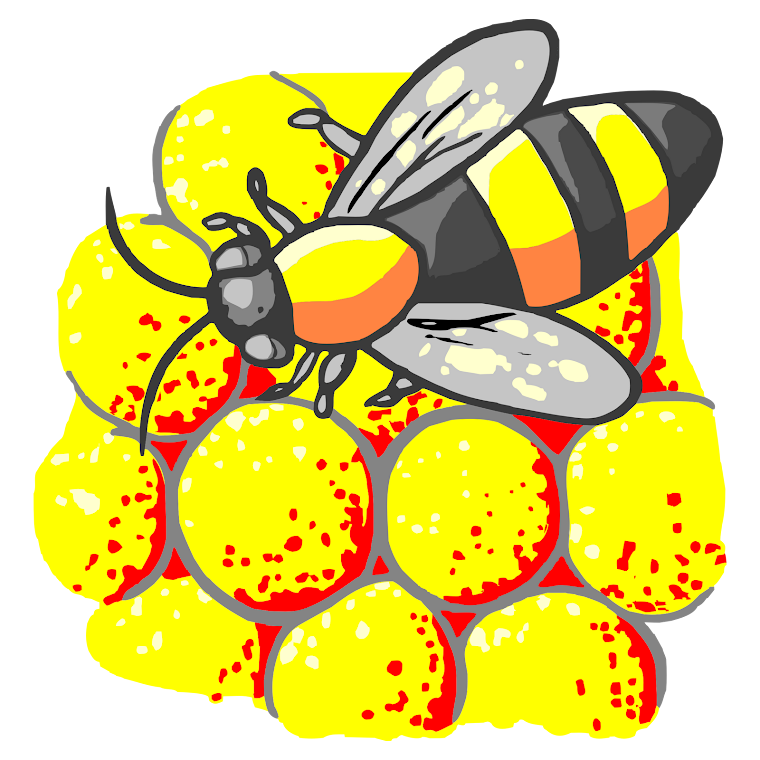LEBAH 8 - Parasit dan Pengganggu Lebah
| Bees have several parasites/competitors. The species making the greatest impact on honeybee populations include bacteria and mites. Each organism and its impacts are briefly outlined below: Bacteria Parasitic bacteria make their most significant impact on young larvae. The diseases most commonly caused by these bacteria are known as American foul brood and European foul brood. American foul brood is caused by Bacillus larvae. Infected colonies containing brood (larvae and pupae) often die. Because the bacterial spores remain viable for decades, it is essential that measures be taken to prevent infection in the first place. Spores are transmitted to the larvae by adult workers, who clean and feed the larvae. Nurse bees often remove some infected larvae though the decomposed larval remains, which are typically loaded with spores, prevent the workers from being able to effectively clean out the brood cells containing the infected and dead larvae.
If the larval cell of an infected larva is capped prior to death, the capping over the larva becomes moist, dark colored, and sunken.
This disease is highly contagious. Destruction of infected colonies by burning is the only proper way to control the spread of this disease. The incidence of this disease is estimated to be 20% in the U.S. European foul brood is caused by Melissococcus pluton. It affects larvae up to 48 hours old, and kills them within several days. Unlike American foul brood, its occurrence is cyclic, with a rapid increase early in the spring. The greatest impact is on small colonies. This condition is less of a concern than American foul brood, in fact many hive owners never realize that their colonies are infected. Colonies moved about for pollination and those with low food reserves are most likely to be impacted. Successful treatment of this condition often occurs as a result of feeding the bees antibiotics (Crane, 1990).
Mites Varroa Mites Varroa mites are natural parasites of the eastern honeybee, Apis surana, from southeast Asia. Unfortunately the honeybees that are found in the U.S. (Apis mellifera) have no adaptations that provide them any significant degree of protection from these parasitic mites (Buchmann, 2005). Varroa mites appear as brown specks ranging from 1-2 mm. in diameter. Males are round and approximately 1 mm. in diameter, whereas the oval females approach 2 mm. in diameter.
Early in the 1980s varroa mites began to make a serious impact on commercial hives. These mites feed on larvae and pupae, feeding preferentially on drone larvae and pupae.
In serious cases, the pupae are killed or develop into adults exhibiting reduced size, incomplete wing development, and atrophied legs. One of the major problems in dealing with these organisms is that their activities go largely unnoticed within capped cells, away from the view of even the most vigilant beekeepers. Adults bees become exhausted in their efforts to remove mites. Feeding of the mites causes the adult to lose vital body fluids, while the breaks in the exoskeleton caused by mite feeding lead to increased likelihood of infection by bacteria, viruses, and other pathogenic agents. Often the mites do not appear to make a significant impact on the bee colony until the third year of mite population establishment, when the mites may consume the entire year's larvae and pupae. Acaracides, pesticides developed specifically for mite control, may reduce mite numbers though there is no completely effective control method (Jean-Propst, 1995). Half of the populations of some bees have decreased over the past 10 years as a result of this mite (Buchmann, 2005).
Tracheal Mites These mites are a natural parasite of the western honeybee. They have been in the U.S. since 1984, and are generally considered a relatively minor pest in many parts of the U.S. (Buchmann, 2005). Only young adult bees are susceptible to this mite. These mites enter the first or second spiracles (air holes) and feed on the wall of the trachea, the tubes used for gas transport. Tracheal mite impact on colonies is often minimal, though infestations in colonies with insufficient food resources further weakens the colony, and may contribute to the eventual death of the these colonies (Crane, 1990).
http://www.uni.illinois.edu//~stone2/bee_parasites_and_competit.html |

Tidak ada komentar:
Posting Komentar